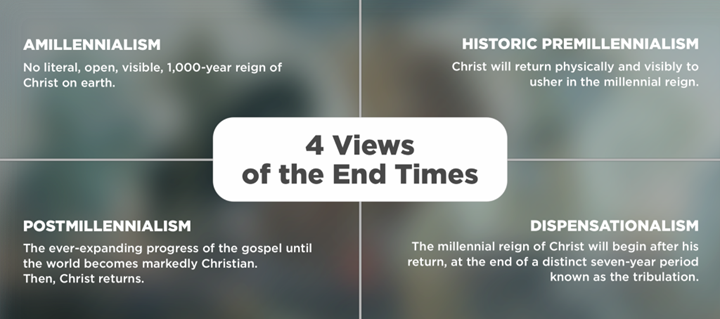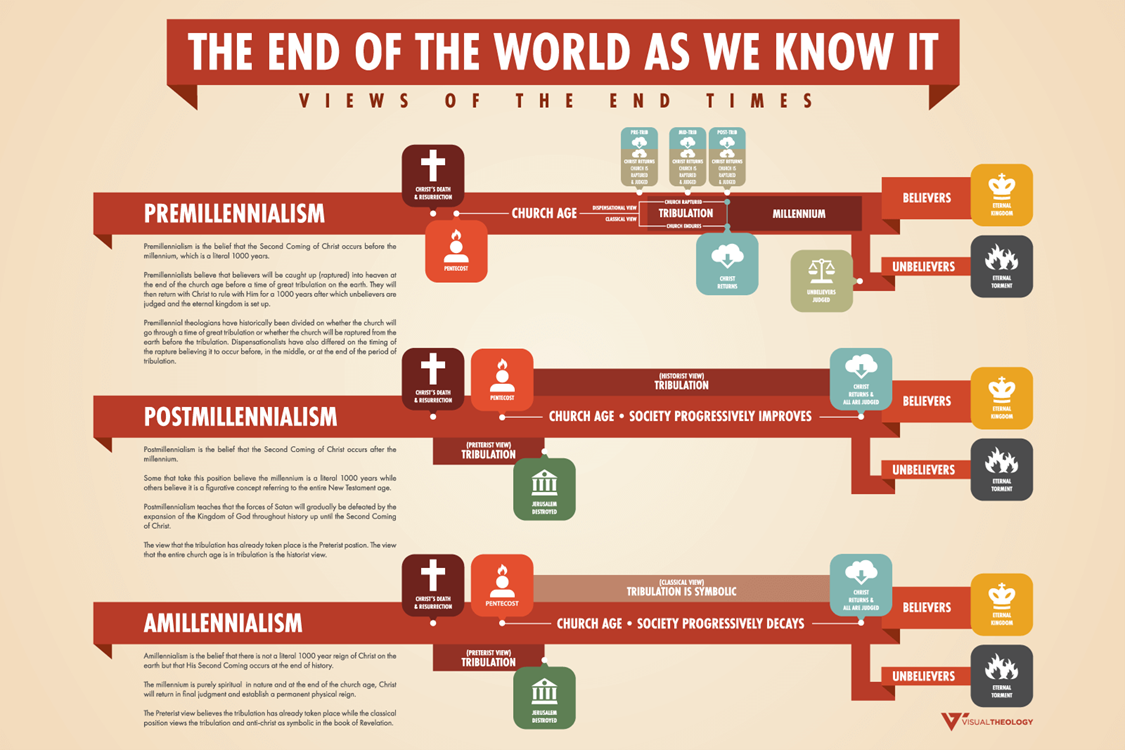2. THE DIVERSITY OF BELIEFS ABOUT THE END TIMES
We need to ask: where has the church been on this issue of end times? Remember, all branches of Christianity agree on the coming of the Lord one day, but Christians differ in their understanding of how to interpret the Scriptures that talk about end times. I’m going to look at four groups very quickly with an overview of their end time beliefs. Where does each group fit on the spectrum?
Preterist view: This view sees the book of Revelation as a prophecy that was fulfilled in A.D. 70. Preterists read Revelation as saying, “Listen, there’s a whole lot of bad stuff coming.” They see the beasts and the judgments and people running for their lives that John describes in Revelation as being events that happened at a particular time in the first century.
Historians would say that the worst time for the Jewish nation was A.D. 70. In the years preceding that, the Jewish people had rebellion upon rebellion against the Roman Empire. Emperor Titus got so sick and tired of dealing with the Jewish people that he besieged the city of Jerusalem, starved them out, and then at their weakest point, he sent in what at the time was one of the largest armies ever assembled in human history, and absolutely decimated the city of Jerusalem. Thousands upon thousands of people were killed. People ran for their lives. To defy the God of Israel, the Romans burned a pig on the altar that was dedicated to the Lord. It was called “the abomination that causes desolation.”
You might ask why they would think this happened in the past. When Jesus was talking about end times—in Mark 13 and Matthew 24‒25—He said, “This generation will not pass away until the fulfillment of My words.” What generation? Some future unknown generation? Or the generation He was speaking to? Again, these are hard verses we don’t like to struggle with. Luke 9:27 says these things will come as a fulfillment that “there are some standing here who will not taste death until they see the kingdom of God.”
Two people who hold this view are R.C. Sproul, a great Bible teacher, and Hank Hanegraaff, who on the radio is called the “Bible Answer Man.”
Historist view: Historicism was especially popular during the Reformation. This view interprets Revelation and all the prophecies of Scripture as telling us what is going to take place in the entirety of human history, from the ascension of Jesus Christ to the second coming. However long human history is between Christ’s first coming and second coming, they believe it will be filled with these events. We cannot pinpoint with great accuracy what those events are, but they recognize these things are going to take place. At some point in the future, after all these events have taken place, Christ is going to come back.
Historicism falls between preterism and futurism in its approach: according to historicism, most of Revelation is symbolic of persons and events in world history. The book of Revelation was prophecy when John wrote it, according to historicists, but most of the book has already been fulfilled in our day.
Some people who held to this view were John Wycliffe, John Knox, William Tyndale, Martin Luther, John Calvin, Ulrich Zwingli, John Wesley, Jonathan Edwards, and Matthew Henry. So we have the founders of the Presbyterian church, the Methodist church, and the Lutheran church. And two men whom God used to bring the Bible to the common man: William Tyndale and John Wycliffe. Historicism remained a dominant perspective on eschatology through the 19th century. However, due to its nebulous interpretation method (no two historicists agree on what symbols go with what historical events) and the fact that John’s original readers could not have understood the book of Revelation in a historicist manner, the historicist view is not widely held today.
Idealist view. This view interprets Revelation and passages such as 1 Thessalonians 4 and 5 as being imagery contained in a book of symbols. The images are not symbolic of events and persons but only of abstract ideas such as good and evil. This view would say not to pinpoint things in Revelation as being anything specific but merely symbolic. Revelation was written to tell us that in the end, good will prevail over evil, and that’s the whole story. Revelation is thus intended to remind us that we should live godly lives because in the end—even though we grow weary of the evil around us—God is going to win, and good will always prevail.
Adherents to this view include Augustine and Karl Barth.
Futurist view. This view teaches that the events of prophecy in Revelation and 1 Thessalonians 4 and 5 are all going to take place sometime in the future. They have had some fulfillment in the past but will have a clearer fulfillment at some point in the future. A futurist interprets the book of Revelation in the following way: chapter one describes the past; chapters two and three describe the present; chapters 4‒22 describe the future.
Adherents to this view were many of the early church fathers such as Polycarp, Justin Martyr, Tertullian—disciples of the first apostles. But this view lost its way somewhere around the third century. The idea of interpreting the book of Revelation and the Thessalonians passage in a futurist way disappeared from church writings from the third century until almost the 19th century. Only in the past 150 years has this view resurfaced, and now it is the most popular view in evangelicalism.
The position we hold is called historic premillennialism. Historic means it’s an old view, the one held by a large majority of the early church fathers (first three centuries of the Christian era).
Historic premillennialism taught that the Antichrist would appear on earth and the seven-year tribulation would begin. Next would be the rapture, and then Jesus and His church would return to earth to rule for a literal thousand years. It’s not symbolic or allegorical. It’s a real thing that will take place at some point in the future.
This position holds that since the ascension of Jesus Christ, we have been living in the last days. So, any time you see the phrase “last days,” it’s not talking about a time in the future. It’s happening right now. We are in the last days. You might say, “Wait a minute. Days? It’s been 2,000 years since Christ lived.” Remember, to Christ, a day is like a thousand years, and a thousand years is like a day (2 Peter 3:8). He’s got His own timetable.
Life as we know it is going to go on. There are going to be good times and bad times. We recognize that on this earth, there will be areas of great peace and areas of great violence and persecution that will go on and on throughout the course of human history. But then, at some point in the future—it may be tomorrow, it may be a thousand years from now—the world as we know it will endure a time of great tribulation, where evil will seem to have unprecedented power.
All the while, during that time, the church will still have major victories. How can that be? How can a church be under so much persecution and see so much growth? Well, let’s remember the book of Acts. They’re being thrown in prison. They’re being killed. And what’s happening? The church is growing and growing and growing. It will be the same during these days. Then, at some point of God’s own choosing, during this time of great tribulation, Jesus Christ will come again. He will establish His Kingdom and He will usher in eternity.
The historic premillennialism position was held by most of the early church fathers (Ireneaus, Papias, Justin Martyr, Tertullian, Hippolytus) and a myriad of contemporary theologians (Charles Haddon Spurgeon, George Eldon Ladd, Francis Schaeffer, James Montgomery Boice, Philip Ryken, John Piper, Alistair Begg, D.A. Carson, Albert Mohler, Mark Dever, and David Platt).
Historic Premillennialism vs Dispensational Premillennialism:
- Dispensational Premillennialism places the rapture at the beginning of the tribulation, whereas historic premillennialism places the rapture at the end of the tribulation.
- Historic Premillennialism doesn't make a sharp distinction between the nation of Israel and the church, but instead, it sees the church as the fulfillment of Israel and yet not completely replacing it.

